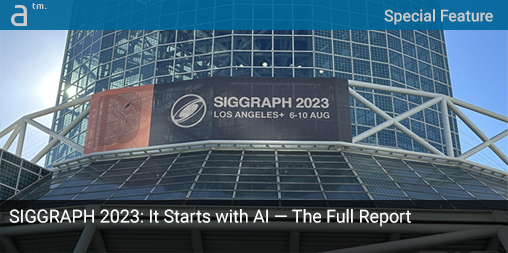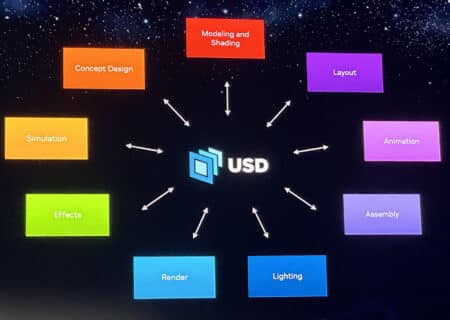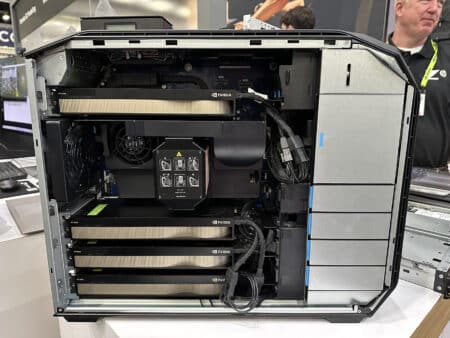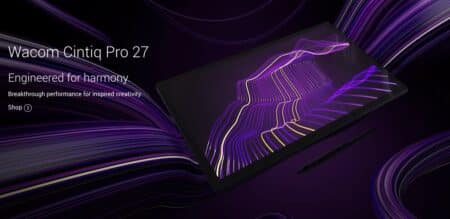LOS ANGELES CONVENTION CENTER PLAYED HOST TO SIGGRAPH 2023. Fourteen thousand two hundred seventy-five attendees from all over the world came to the 50th Anniversary show with great anticipation to attend in person after the Pandemic.
Introduction
This year the convention’s focus was strictly on AI (artificial intelligence). Attendance was lower than in previous years, and the Exhibits Hall was one-third of the size I remember before the global pandemic. The “new normal,” as they call it, is bearing out on physical events in possibly a permanent way. Though vendors are using meeting rooms, the meeting rooms were located upstairs where demonstration artists could do their presentations without interruption. You didn’t need a full conference badge to attend these sessions.

SIGGRAPH 2023 had smaller visitors than in the past prior to the global pandemic, but one can’t also rule out the writers strike and its impact on types of film industry professionals who normally attend this conference.
The entire second floor was filled with meeting rooms completely swamped by attendees lined up for the sessions by their vendor of choice. I spent some time in the Unreal Engine, Houdini, and NVIDIA presentations. The meeting rooms worked; I could focus on what the presenter was saying, considering the complexity of the subject matter. As I noted earlier, the big focus was on AI and ML.
AI is a controversial subject considering the current strikes with WGA and SAG-AFTRA. AI is a crucial component in the negotiations, as the guilds ask that AI not replace the many jobs today filled by people. It is possible the strikes may have influenced the low attendance numbers at the show this year, but that is just a hunch.
AI, Digital Twins, and USD
There are three critical inter-related technology trends impacting all 3D digital industries right now, and they were talked about and shown extensively at SIGGRAPH 2023. Aside from AI, Digital Twins, and USD (now OpenUSD) are all playing a major role. For example, Architosh recently covered the Alliance for OpenUSD (AOUSD), which was backed by Pixar, Apple, Adobe, Autodesk, and NVIDIA.

This year meeting rooms rivaled the expo floor for showcasing new software and hardware at SIGGRAPH 2023 as attendees found the new format interesting and helpful.
AI is definitely a hot trend impacting the AEC/O industry, as Architosh writes about extensively, especially in its monthly newsletter devoted to emerging technologies, Xpresso. Also, digital twins are a big part of NVIDIA’s Omniverse which is powered by USD.
Amazon, BMW, and other major corporate companies are using digital twins to create factories, in-house robotics, and warehouse designs that are more efficient. They don’t build anything until they refine it in the digital twin first. Autodesk, Adobe, and Epic Games (Unreal Engine) are some of the companies using AI to make their software do tasks faster so you can get things done in real-time or work with someone else simultaneously.
The release of Meta Humans from Unreal Engine allows AEC professionals using the engine to populate their renderings and animations with photo-realistic people. It didn’t require learning how to model or animate humans. This is one example of cutting-edge technology crossing over industry boundaries.
The Big Open Standards Push
The Alliance for OpenUSD (AOUSD) could be said to be just as crucial as AI in 3D industries because it helps propel the advancement of the Metaverse (Omniverse in NVIDIA’s case). This big support for a unified standard in OpenUSD likely means both AEC/O and the D&M (design and manufacturing) industries and their leading tools will soon be supporting this new format, and it will impact workflows possibly dramatically.
OpenUSD and its massive industry support mean the AEC/O industry, in particular, has a new interoperability champion for users and software vendors alike to push forward. This is encouraging news and specifically addresses the lock-in issues and other grumblings from those AEC/O users who signed either of the two versions of the Revit Open Letters. (see: Architosh, “The Revit Open Letter Through the Lens of QWERTY-Nomics,” 20 Oct 23).
Amazon, BMW, and other major corporate companies are using digital twins to create factories, in-house robotics, and warehouse designs that are more efficient.
SIGGRAPH was once a place for key announcements from major vendors but due to a change in the business climate, most key updates are announced at their own events and keynotes, and the new announcements on the show floor are more from new fresh faces in the tech arena. Let us now talk about Jensen Huang’s SIGGRAPH 2023 keynote talk and what NVIDIA has introduced lately and showcased at the show.
NVIDIA CEO the new Steve Jobs?
When Jensen Huang first stepped out on the stage, it reminded me of Steve Jobs. Every person in the room was eagerly awaiting to hear what he had to say. There are actually “Jensen groupies.” I can say he didn’t disappoint with his charismatic charm.

NVIDIA’s new Grace CPU is a custom ARM-based chip and a super chip for AI workloads in all kinds of industries.
The first thing he showed us was the new GH (Grace Hopper) chip. It is an ARM-based super chip for AI. It is ten times cheaper using less power, making it much more affordable. He began explaining how building servers from NVIDIA GPUs was far cheaper than doing it with a conventional Intel or AMD CPU. He said, “The more you buy, the more you save,” as showed a large server array behind him, demonstrating the powerful hardware to power AI while reducing power and cost.
NVIDIA announced a partnership with Hugging Face Platform for generative AI models that has over 250,000 models that you can fine-tune for whatever you need. Hugging Face will integrate its training service with NVIDIA’s Cloud GPU. NVIDIA announced Enterprise 4.0, a significant upgrade to their enterprise AI software so organizations can use a toolkit to process generative AI. NeMo allows developers to build and customize large-scale models with billions of parameters. NVIDIA also announced AI Workbench, which will enable users to work on a PC flexibly, NVIDIA’s DGX Cloud, or other cloud services and move between these locations with just one click.
Omniverse evolves at NVIDIA, reshaping manufacturing, transportation, and telecommunications industries. Omniverse is a tool that lets architects, engineers, and construction companies work with their artists and designers in real time on architectural visualizations in 3D. It helps create realistic visualization by using USD (OpenUSD). NVIDIA made significant updates to Omniverse, enhancing the rendering power of Omniverse and adding more centralized tools that simplify the management of Omniverse for Developers.
New RTX workstations were announced with three new GPUs, RTX 5000 (available), RTX 4500 (coming October), and RTX 4000 (coming in September). The RTX 4000 could be the most potent single-slot GPU. I saw the Z8 Fury on the show floor by HP; it was stacked with NVIDIA GPUs with room for two terabytes of RAM. Again, as Jensen Huang says, “The more you buy, the more you save.”
To learn more about NVIDIA visit them online here: https://www.nvidia.com
Here are some cool announcements from some new companies and some you may already know.
CAVRNUS
Cavrnus is a visualization tool that delivers spatial vision with stunning graphics with a multi-person presence, including voice, video, and screen share. The 3D interactive workflows for Unity and Unreal Engine, plus additional tools, including a robust SDK with a suite of APIs. Cavrnus is a bit like Omniverse in how you can communicate inside of Unreal or Unity in real time to work on projects together and communicate and manage your experience across platforms and communities. I watched as a group of people communicated in Unreal Engine in real time about designing a space. The users used both chat and videos to communicate their needs and their designs. This tool may be coming to Twinmotion soon, but I can’t deny or confirm this.
MATEREAL
Matereal is a French start-up founded in 2021 based on research of the Tribology & System Dynamics Laboratory (LTDS) of the ENTPE. They specialize in measuring materials’ visual appearance based on realistic and physically accurate 3D rendering. Matereal is building a library of textures and shaders they have created using these materials for architectural visualization, animation, and VFX. They provide high-precision spectral BRDF and their equivalent in sRGB and XYZ color spaces for various 3D renderers. The company specializes in measuring surfaces based on the renderings’ look accuracy. They also offer a service to users to measure a material they’d like to use in a rendering and make it realistic and accurate.
UNITY WETA TOOLS
WETA Tools, which was acquired by Unity in 2021, had a large meeting room on the second floor of the Convention Center. One great tool they introduced, Speedtree 9.5, allows for photo-realistic trees and vegetation that look better than many other procedural trees with shapes and sizes that work on any scale. This will help with architectural renderings to help them feel more life-like and more varied.
Other tools WETA Tools introduced at SIGGRAPH include:
- WETA Tools:
- Deep Comp (GA)
- Eddy (GA)
- Wig (beta SIGGRAPH)
- Ziva VFZ 2.3 (GA)
- Ziva RT (trainer, player, animator (GA)
- Speedtree 9.5 (GA SIGGRAPH) (GA-Sept.)
- Speedtree Asset Library (Sept)
- Cloudtree (Beta Sept)
https://unity.com/solutions/unity-weta-tools
VICON
Vicon debuted its markerless motion capture technology in collaboration with Artanim, the research arm of Dreamscape, a leading VR company. Vicon showcased a six-person markerless real-time solve set in Dreamscape VR called “The Clockwork Forest.” It was fun interacting with others to solve a puzzle. It is rather impressive and works to keep you from feeling nauseous. It is worth knowing about this technology as the dawn of the Metaverse approaches.
WACOM
Wacom had a booth showing off the new Cintiq 27 with a virtual production setup for the new Cintiq. They also announced the new Wacom One family of tablets, which are four tablets in two varieties. Wacom One 12 ($399) and Wacom One 13 touch ($599) are pen display tablets with built-in screens while also introducing two new traditional pen tablets with no display Wacom One S ($99) and Wacom One M ($149.99).
Wacom One 12 and 13 tablets have displays that are great for PC users who can’t use the iPad Pros as a tablet. The displays feature 1920 x 1080 resolution with 99 percent sRGB coverage. The Wacom 13 touch also supports Wacom’s 10-finger multitouch gestures, which allow users to navigate using familiar hand movements like pinching and swiping. It is very similar to an iPad. The Wacom One S and M are the company’s first entry-level pen tablets with 4K pressure sensitivity and tilt support. A customized stylus ships with all four versions of the tablet and comes in various colors.
AUTODESK AND HYPERTEC
Here are a few more announcements from the show. Autodesk opened their Autodesk Vision Presentation with the tagline “world builders welcome.” Hypertec was one of the companies powering the Autodesk show floor booth with robust liquid cooling workstation computers with powerful RTX cards by NVIDIA. Everyone said, “Go see the new liquid-cooled hardware.”
Hypertec’s Kronos W405T-G6 machines featured:
- AMD Ryzen Threadripper PRO 5995WX 64 cores
- Up to 2TB of DD4 3200MHz RAM,
- Up to 3 x NVIDIA Quadro RTX6000 cards,
- 3x M.2 (PCIe x4/SATA), 2 x U.2 NVMe and 8 x SATA
- High-performance liquid cooling system,
- 1200W 80 PLUS Platinum certified power supply.
The Foundry
The Foundry attended SIGGRAPH, giving users the latest updates on their products. NeRF was another popular topic at SIGGRAPH NeRF, also known as neural radiance field, is a fully connected neural network that can generate novel views of complex 3D scenes. NeRF art generated by AI was a big hit with many attendees. An entire gallery was dedicated to NeRF works, including a party at the end of SIGGRAPH.
The Foundry has long held the excellent 3D modeling tool Modo, and it is now up to version 16.1.
Pixar
Renderman was back with their User Group and new collectible teapot for the movie, “Elemental.” SIGGRAPH featured a Renderman Museum display for past Renderman teapots that attendees have collected over the years.
AMD and Boris FX
AMD announced their Radeon Pro W7600 graphics cards designed to tackle workloads for AEC and media and entertainment. (see: Architosh, “AMD Intros two new high-performance Radeon PRO graphics cards,” 18 Aug 23). AMD’s Radeon Pro W7500 and W7600 are perfect for architects with a great price point for a mid-range graphics card. Boris FX is thrilled to partner with AMD for power users to create and render stunning visual effects with accelerated speed. AMD also sponsored the Renderman “Lost Things” Art Challenge.
Wild Capture was at SIGGRAPH, talking with companies about their software. Wild Capture continues to pursue its vision of standardizing the digitization of human performance with tools that simplify the process. The company 4D Views announced the launch of their next-generation volumetric capture system, the HOLYSYS+.
SideFX and Maxon
SideFX did several presentations inside the meeting rooms focused on their new release of Solaris and other features. Maxon had a big booth on the show floor with many top presenters showing off the new updates to Maxon products.
Closing Remarks
Computer Graphics is changing exponentially at this moment. It is very important to consider the advancements in AI in all aspects of the pipeline, from the desktop to the server.
Visualization is changing with a single format, including AI tools streamlining work and design to be faster and more efficient. It is said that NVIDIA has changed the Face of AI with its GPU. AEC is already seeing this change with Twinmotion, Unreal Engine, and Unity.
Autodesk now provides a license of Twinmotion with a purchase of Revit. Digital Twins are changing the way big corporations are designing their factories, warehouses, and manufacturing plants. And they are a big part of the AEC/O industry at both the building, plant, and infrastructure levels. It is so much cheaper to find an error in a design phase, especially structural or engineering errors, in a Digital Twin than after you have built it.
Apple will soon release the Vision Pro goggles, bringing the Mac universe into the metaverse. Can you imagine how this will change the way we work and socialize? If the Apple Vision Pro is a hit, this will accelerate the innovation and growth of the metaverse. USD (Universal Scene Description) format is here to stay. AI and ML will be everywhere if it isn’t already—this is not a fad, or something will fade away. It is the future of how we work, socialize, and create.
If you have any questions, feel free to ask them here on Architosh in the comments section below.








Reader Comments
Comments for this story are closed